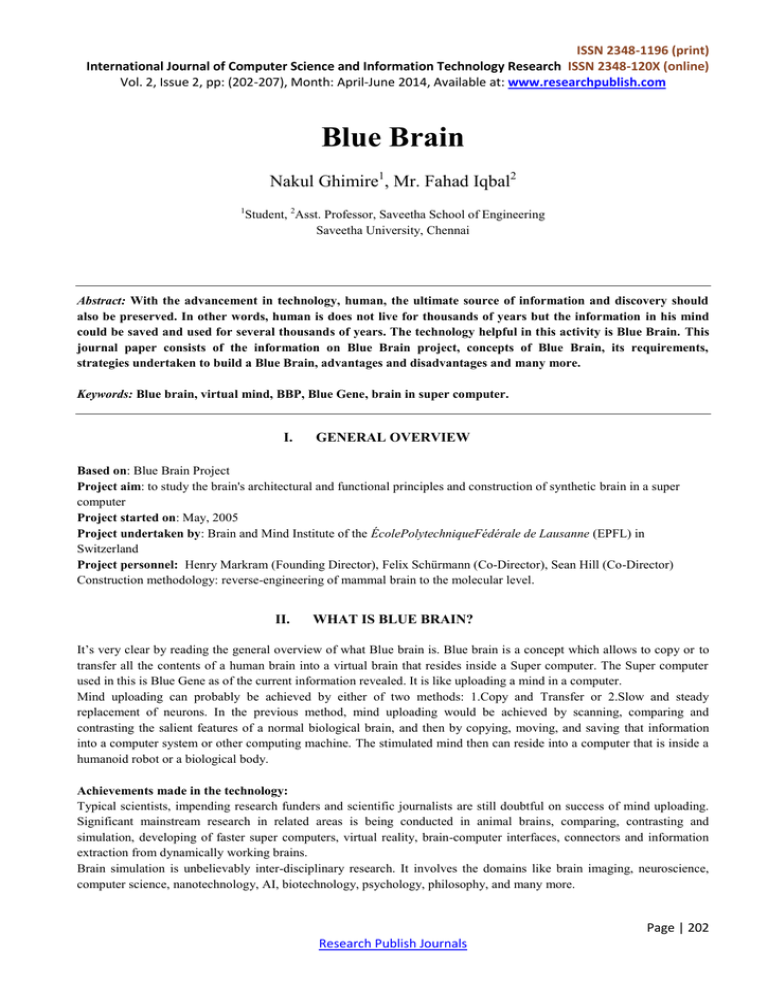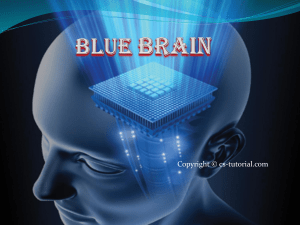Complete Paper - Research Publish Journals
advertisement

ISSN 2348-1196 (print) International Journal of Computer Science and Information Technology Research ISSN 2348-120X (online) Vol. 2, Issue 2, pp: (202-207), Month: April-June 2014, Available at: www.researchpublish.com Blue Brain Nakul Ghimire1, Mr. Fahad Iqbal2 1 Student, 2Asst. Professor, Saveetha School of Engineering Saveetha University, Chennai Abstract: With the advancement in technology, human, the ultimate source of information and discovery should also be preserved. In other words, human is does not live for thousands of years but the information in his mind could be saved and used for several thousands of years. The technology helpful in this activity is Blue Brain. This journal paper consists of the information on Blue Brain project, concepts of Blue Brain, its requirements, strategies undertaken to build a Blue Brain, advantages and disadvantages and many more. Keywords: Blue brain, virtual mind, BBP, Blue Gene, brain in super computer. I. GENERAL OVERVIEW Based on: Blue Brain Project Project aim: to study the brain's architectural and functional principles and construction of synthetic brain in a super computer Project started on: May, 2005 Project undertaken by: Brain and Mind Institute of the ÉcolePolytechniqueFédérale de Lausanne (EPFL) in Switzerland Project personnel: Henry Markram (Founding Director), Felix Schürmann (Co-Director), Sean Hill (Co-Director) Construction methodology: reverse-engineering of mammal brain to the molecular level. II. WHAT IS BLUE BRAIN? It’s very clear by reading the general overview of what Blue brain is. Blue brain is a concept which allows to copy or to transfer all the contents of a human brain into a virtual brain that resides inside a Super computer. The Super computer used in this is Blue Gene as of the current information revealed. It is like uploading a mind in a computer. Mind uploading can probably be achieved by either of two methods: 1.Copy and Transfer or 2.Slow and steady replacement of neurons. In the previous method, mind uploading would be achieved by scanning, comparing and contrasting the salient features of a normal biological brain, and then by copying, moving, and saving that information into a computer system or other computing machine. The stimulated mind then can reside into a computer that is inside a humanoid robot or a biological body. Achievements made in the technology: Typical scientists, impending research funders and scientific journalists are still doubtful on success of mind uploading. Significant mainstream research in related areas is being conducted in animal brains, comparing, contrasting and simulation, developing of faster super computers, virtual reality, brain-computer interfaces, connectors and information extraction from dynamically working brains. Brain simulation is unbelievably inter-disciplinary research. It involves the domains like brain imaging, neuroscience, computer science, nanotechnology, AI, biotechnology, psychology, philosophy, and many more. Page | 202 Research Publish Journals ISSN 2348-1196 (print) International Journal of Computer Science and Information Technology Research ISSN 2348-120X (online) Vol. 2, Issue 2, pp: (202-207), Month: April-June 2014, Available at: www.researchpublish.com A progressively vast community of thoughtful researchers has arisen, taking this seemingly science-fictional knowledge seriously and running to it through experimental and theoretical research programs. These supporters mention many of the tools and ideas needed to achieve mind uploading activity; however, they also admit that it is very hypothetical, but still in the dominion of engineering potential. Fig. Neuron anatomical model Fig. simple artificial neural network A typical human brain consists of approximately 85.5 billion of nerve cells called the neurons. Each neuron is individually linked to other neurons by axons and dendrites. Signals at the biological level of these connections are transmitted by releasing and detecting chemicals known as neurotransmitters. Neuroscientists have stated that important functions that a mind performs such as learning, memory, and consciousness, have been possible due to completely physical and electrochemical processes in the brain. Consciousness is a part of natural world. We believe that consciousness depends on mathematics and logic, laws of physics and chemistry and biology; it’s not magical. The concept of mind uploading is based on this mechanical view of the mind. It denies the ritualistic view of human life and consciousness. Eminent computer geniuses and neuroscientists have foretold that specially programmed machines will be capable of thought and even reach some level of consciousness. Such machine intelligence ability might offer a computational substrate necessary for uploading. III. 1. 2. 3. STEPS TO BUILDING A BLUE BRAIN Data collection Data simulation Visualization 1. Data collection: It involves collecting brain portions, taking them under a microscope, and gauging the shape and electrical behavior of neurons individually. This method of studying and cataloguing neurons is very familiar and worldwide. Fig. The 12 patch clamp, close view Fig. 3D neuron morphology reconstruction Page | 203 Research Publish Journals ISSN 2348-1196 (print) International Journal of Computer Science and Information Technology Research ISSN 2348-120X (online) Vol. 2, Issue 2, pp: (202-207), Month: April-June 2014, Available at: www.researchpublish.com The neurons are captured by their shape, electrical and physiological activity, site within the cerebral cortex, and their population density. These observations are translated into precise algorithms which describe the process, function, and positioning methods of neurons. Then, the algorithms are used to generate biologically-real looking virtual neurons ready for simulation. 2. Data simulation: It concerns with two major aspects: a. Simulation speed b. Simulation workflow Simulation speed Simulations of one cortical column (more than 10,100 neurons) run about two hundred times slower than real time. It takes about five minutes to complete one second of stimulated time. The simulations display unevenly line scaling. Presently the major seek is biological soundness rather than presentation. After understanding biologically significant factors for a given effect it might be feasible to crop constituents that don't subsidize in order to advance performance. Simulation overflow Making virtual cells using the algorithms, written to define and describe real neurons, is the major seek of this step. Algorithms and constraints are adapted according to the age, species, and disease stage of the animal being simulated. Each one of the protein is simulated. Note: there are hundreds of millions of proteins in one cell. a. First a network skeleton is built from all the different kinds of synthesized neurons. b. After this, the cells are joined according to the experimentally found rules. c. Finally the neurons are functionalized and the simulation brought to life. The blueprints of emerging behavior are watched with visualization software. BBP-SDK The Blue Brain Project - Software Development Kit, a set of Application Programming Interfaces allows the researchers to use and audit prototypes and simulations. The Blue Brain Project-SDK is a C++ library wrapped in Java and Python. The primary software used by this for neural simulations is NEURON. Michael Hines of Yale University and John Moore at Duke University developed this in the starting of the 1990s. It uses C, C++, and FORTRAN. It is freely available open source software. The website makes everything available including the code and the binary data freely. Michael Hines in cooperation with BBP team in 2005 ported the package into the massive and parallel Blue Gene. Fig. NEURON cell binder window Page | 204 Research Publish Journals ISSN 2348-1196 (print) International Journal of Computer Science and Information Technology Research ISSN 2348-120X (online) Vol. 2, Issue 2, pp: (202-207), Month: April-June 2014, Available at: www.researchpublish.com 3. Visualization of results RT Neuron RT Neuron is the main application that Blue Brain Project uses for visualization of neural simulations. The BBP team developed this software internally. It is coded using C++ and OpenGL. RT Neuron is an ad-hoc software written specifically for neural simulations, i.e. it can’t generalized to other kinds of simulation. RT Neuron takes the output from Hodgkin-Huxley simulations as input in NEURON and delivers them in 3D. This allows the programmers and researchers to view as activation potentials propagate through or between neurons. The animations can be paused, stopped, started and zoomed, hence allowing the researchers to interact with the model. The visualizations are multi-scale (they can render individual neurons or a whole cortical column). Fig. Visualization of neuron IV. 1. 2. HARDWARE/ COMPUTER USED Blue Gene/L Super computer (initially till 2009) Blue Gene/P Super computer (till 2011) Blue Gene/P specifications: More than 4,000 quad-core nodes Each core is a PowerPC of 4.5, 8.5 GHz It consists of more than 6*1013flops, more than 15 terabytes memory 1 PetaByte of disk space and parallel file system Operating system: Linux SuSE SLES 10 Fig. Blue Gene/P’s processing system outer view Page | 205 Research Publish Journals ISSN 2348-1196 (print) International Journal of Computer Science and Information Technology Research ISSN 2348-120X (online) Vol. 2, Issue 2, pp: (202-207), Month: April-June 2014, Available at: www.researchpublish.com 3. JuQUEEN (Blue Gene/Q) Super computer Fig. JuQUEEN It currently performs at more than 1.7 Petaflops. It was in 8th rank in the world in June 2012 in terms of speed. It was upgraded with more racks in October 2012. V. FUNDING The project was funded chiefly by EPFL, to which Swiss government donates in turn. EPFL and ETH are the only two federally-funded universities in Switzerland. Thisproject has also been funded by other organizations like EU research grants and other entities, and individuals. In the March of 2012 the ETH Board requested an amount ofCHF 85 million (€70 m) from the Swiss government to fund the Blue Brain Project during 2013 to 2016. IBM actually isn’t funding the project, but they gave their supercomputer named Blue Gene to Ecole Polytechnique Federele De Lausanne at a minimal cost.IBM was actually interested in evaluating and examining the super computer on different fields and BBP was one of them. VI. ADVANTAGES AND DISADVANTAGES Advantages of Blue Brain 1. 2. 3. 4. 5. Blue brain is an approach to store and utilize human intelligence and information present in the mind even after human demise. It is an important move towards self-decision making by the computer or machine that holds a Blue brain. Business analysis, attending conferences, reporting, etc. are very significant functions that an intelligent machine can do consistently. It can be used as an interface between human and animal minds. The BBP has become successful in rat and some other animals which is a sign of success. It a good remedy towards human disability like a deaf can get the information via direct nerve stimulation. Disadvantages of Blue Brain 1. 2. 3. It increases the risk of human dependency on Blue Brain every time. Once a Blue Brain related to a particular person’s neural schema is hacked, the brain could be used against the very person. Since it an approach to make machines intelligent and thoughtful it increases the risk of machines conducting war against human (like we have been watching in the movies like Terminator, Universal soldier, etc.) Page | 206 Research Publish Journals ISSN 2348-1196 (print) International Journal of Computer Science and Information Technology Research ISSN 2348-120X (online) Vol. 2, Issue 2, pp: (202-207), Month: April-June 2014, Available at: www.researchpublish.com ACKNOWLEDGEMENT We would like to thank Asst. Prof. Mr. Fahad Iqbal for helping us with information and support. REFERENCES [1] http://www.sim.me.uk/neural/JournalArticles/Bamford2012IJMC.pdf [2] Sandberg, Anders; Boström, Nick (2008). Whole Brain Emulation: A Roadmap. [3] Joha Johansson C and Lansner A., Towards cortex sized artificial neural systems. Neural Networks nsson C and Lansner A., Towards cortex sized artificial neural systems. Neural Networks, 2007 [4] http://www.ijareeie.com/upload/2014/apr14-special/7_anoopsaveetha.pdf [5] http://www.theglobaljournals.com/ijar/file.php?val=August_2013_1375511933_1c067_60.pdf [6] http://www.artificialbrains.com/blue-brain-project [7] http://www.ijaiem.org/Volume2Issue3/IJAIEM-2013-03-28-091.pdf [8] http://en.wikipedia.org/wiki/Brain_upload [9] http://en.wikipedia.org/wiki/Whole_brain_emulation [10] http://www.slideshare.net/kusumagroiya/blue-brain-26260533 [11] http://archive.org/stream/SingularityWikibook/Singularity-Wikibook_djvu.txt Page | 207 Research Publish Journals







